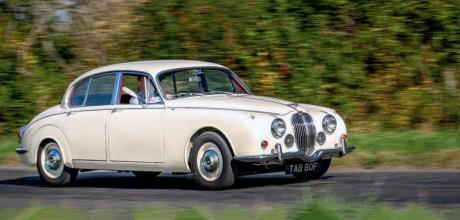1968 Jaguar 240
We investigate the rebirth of a late-model member of the Mk2 family, a special survivor with just one surname in the logbook. Words: Ray Ingman. Photography: Greg Evans.
ONE FAMILY 1968 Jaguar 240
A restoration story with a very personal connection – and a happy ending!
FAMILY OWNED 240
Matt Finch, current custodian of the Old English White 240 that will have caught your eye on the front cover, has something in common with XJ6 Series III owner, Ray Reed, who featured in our October/November 2021 issue: he has no great affection for the wider Jaguar marque and his car is the one and only example he’s ever likely to own… assuming you don’t include a childhood Dinky toy replica. Where the stories diverge, however, is that whilst Ray purchased his car a couple of years ago to fulfil a personal ambition, Matt’s ‘Mk2’ has been present throughout his whole lifetime.
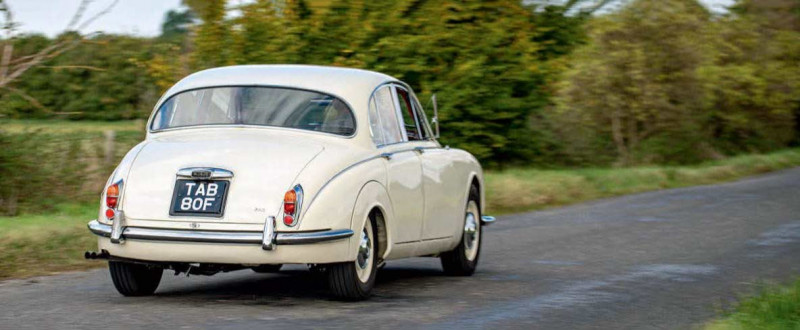
JDHT records reveal that TAB 80F was manufactured on 26th January 1968 and immediately dispatched to the distributor – PJ Evans in Birmingham – before finding its way to the Kidderminster-based dealership of Stanley Goodwin and Son. Meanwhile, Matt’s father, Ron, had decided to reward his hard work in the family’s fish and chip shop by treating himself to a prestige car – and after brief consideration of a Rover P5, his attention turned to the rather more sporting image of a Jaguar.
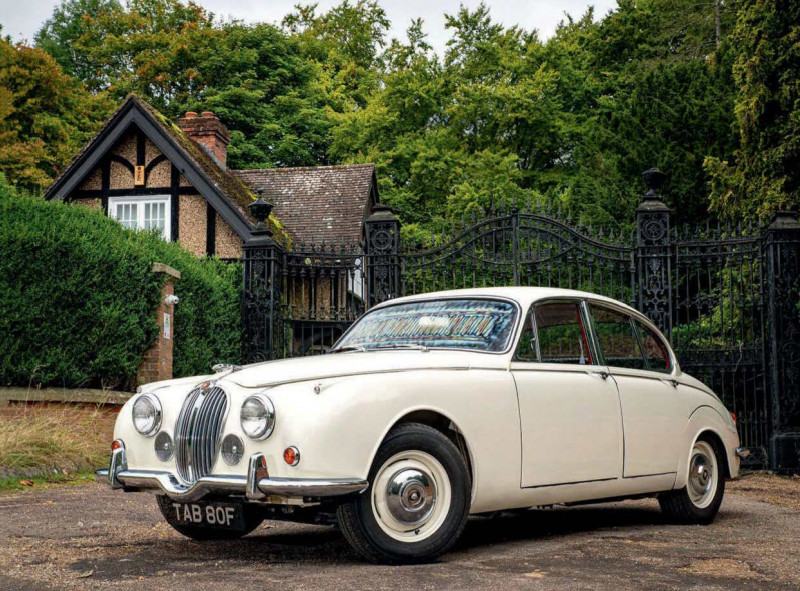
Ron’s vision was an S-type in light metallic blue with red leather trim. Intriguingly though, he discovered that the S-type’s 15’ 7” length wouldn’t fit behind the sliding doors of his home garage – an important observation that I’m not sure would have occurred to everyone in the midst of new car purchase euphoria! But there was a solution. Living up to the epithet ‘compact Jaguar’, research revealed that at 14’ 11” in length, secure door closure would be possible with a 240/340 model.
“In Matt’s mind, the Jaguar was how he had left it: clean and polished with maybe a coating of dust.”
A visit to Goodwins revealed the white 240 with black ambla vinyl trim to be a stock item. Ron considered it for a short while; it was the wrong colour and wrong trim. The dealer then offered to repaint the car in order to clinch the deal, a concept that seems unthinkable in this day and age. This offer was declined, however, and the car purchased ‘as was’ for £1050 on 10th February, a mere 15 days after its manufacture.
Ron was evidently satisfied with his new acquisition, only adding a radio and aftermarket foglamps to the standard specification. “He used to say that owning the car made him feel like a king and that entering it was like donning his best suit,” recalls Matt. To put the Jaguar purchase into perspective, a similar sum in 1968 would have bought a terraced house in the Kidderminster area. Obviously, fish and chips were a commodity in high demand in the then prosperous carpet manufacturing town.
NEW ARRIVAL
Matt came into the world twenty months later in October 1969, during which time – despite it being a ‘second’ car – the Jaguar’s service records show it had covered 21,260 miles in its first couple of years. Much of this distance was accounted for by frequent family holidays to the seaside, early memories of which cemented Matt’s affection for the car.
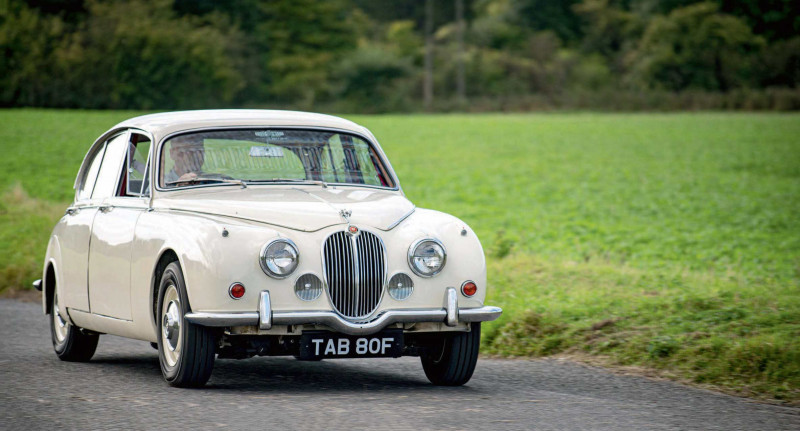
The West Midlands is not known for its coastline, so the nearest stretches of sand were Weston-Super-Mare in Somerset and Barmouth in mid-Wales, each one being over a hundred miles from home. Matt recalls night-time journeys where he would straddle the rear transmission tunnel, place his head between the front seats and marvel at the pale green lightshow illuminating the headlining from the instrument lights. Isofix child seats and safety legislation were still around four decades away.
“The restoration will continue, with improvements to the woodwork and eventually those black seats."
An incident that stuck in the family’s collective memory was a trip up the coast from Barmouth to Blackrock Sands, where the car was parked on the beach for the day. Returning from play and picnicking, the 240 had sunk up to its axles and was immovable! The panic of an advancing tide was alleviated when a tractor was found and borrowed from a neighbouring glider school, saving the car from a watery grave.
Matt suspects the origin of excessive corrosion on the front and rear axles may be traced back to that day. Added to the memorable family journeys, Matt recalls two particular stories his dad used to recount. One was a trip with three friends to watch their local football team, West Bromwich Albion, play away against Brighton. Proudly demonstrating the performance of the Jaguar, it was the first time he had ever driven at 100mph – admitting that it was probably aided by a downhill stretch of road. Perhaps the improved 240 specification of E-type derived cylinder head, SU carburettors and dual exhaust system played their part, endowing the model with a 106mph top speed and 0-60 acceleration time of 15.5 seconds. (The previous 2.4 Mk2 model may have needed a steeper hill, with its 10mph slower maximum and 4.8 seconds longer 0-60 sprint.)
The second story involved a ‘party trick’ demonstration of the 240’s magical properties to Matt’s Auntie Jean. Ron convinced her that clapping would dip the headlights – the reality being that in a ‘look, no hands’ manner, the foot-operated dipswitch could be unobtrusively employed in response to each clap. This was all well and good, but the joke may have worn a bit thin over time, as Auntie Jean’s fascination with this feature never waned.
The family’s working car at the time was a Mini Countryman, whose primary task in life was to pick up sacks of potatoes for the chip shop – saving the Jaguar the ignominy of such a task.
INTO HIBERNATION
A subsequent change of financial circumstances was dictated by the ‘double whammy’ of the previously main road business location being downgraded to a cul-de-sac, thus reducing passing trade. This was also declining due to the demise of the carpet industry and consequent prosperity of the area. Another factor, following the 1979 oil crisis, was the increasing cost of fuel; Ron saw the writing on the wall when the price soared from 28 to 35p/litre, which seems laughable in retrospect but very real in the context of the time. The Jaguar was duly laid up in 1982. Decreasing use had meant that every time Ron wanted to drive the car, the battery would be flat or some other problem – usually ignition related – would present itself. Matt’s last teenage memory of the 240, which at that time was now showing around 90,000 miles on the odometer, was cleaning it inside and out, then helping his dad push it into their lock-up garage. He distinctly remembers having the thought that, one day, he would drive the car himself. Ron’s subsequent motoring history involved a string of Ladas, during which time the Jaguar lurked in the lock-up, semi-forgotten and ageing. Meanwhile, Matt had grown up, left home and moved 115 miles south-east across country to Hitchin in Hertfordshire. The years rolled by, and visits home were never supplemented by viewing the Jaguar; Matt just subliminally knew it ‘was there’. Family started and career settled, finally the nagging ambition in the back of his mind came to the fore. In 2013, the decision was made to exhume the relic, bring it to Matt’s home and start its recommission.
“Comprehensive inspection revealed a concoction of significant corrosion, water-damaged trim and seized mechanical components”
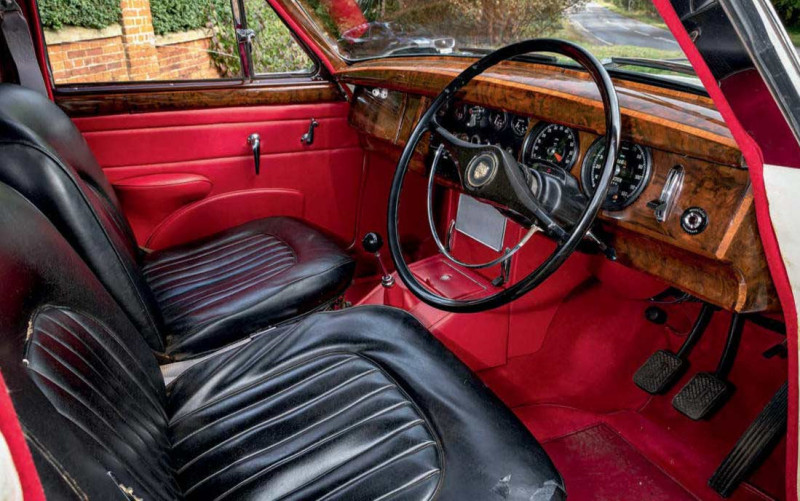
Naturally, things didn’t go quite to plan. In Matt’s mind, the Jaguar was how he had left it: clean and polished with maybe a coating of dust. The true horror was revealed, however, when the doors were opened and the 240 blinked in the light for the first time in 30 years. (Not strictly true, because the flat roof of the garage had been used as a children’s playground and its partial failure had let in not only shafts of light, but years of rain and snow – creating a sweatbox environment that did the occupant’s condition no favours whatsoever.) It wasn’t possible to move the car due to seized brakes and the passenger-side tyres having lost all pretence to inflation, and so a thorough inspection had to wait until the car could be moved to Hertfordshire.
A professional recovery company was commissioned and the deed carried out, the operative commenting that the 240 certainly had character – maybe defiance? Safely ensconced in a friend’s lock up garage, Matt could commence with cleaning and appraising the family Jaguar – and it soon became apparent that recommissioning it was far beyond the capabilities of T-Cut. The services of an expert restorer would be required.
DISAPPOINTING START
In a Lord Voldemort-esque ‘he who must not be named’ style, a local company was located and the car once more consigned to a transporter. In an all too familiar story, however, it then languished outside under a cover for three years. Finally, the continuous excuses and broken promises proffered ran out of all credibility and event-empered Matt cracked. He decided there and then to Google ‘car restorers in my area’, with his phone suggesting Town & Country Classics in nearby Kimpton. Before any more grass grew, a call was placed and company owner, Chris Smith, answered. The ensuing conversation gave Matt confidence, particularly when he was invited to view a recently completed Triumph Spitfire restoration that was about to be collected by its owner that day.
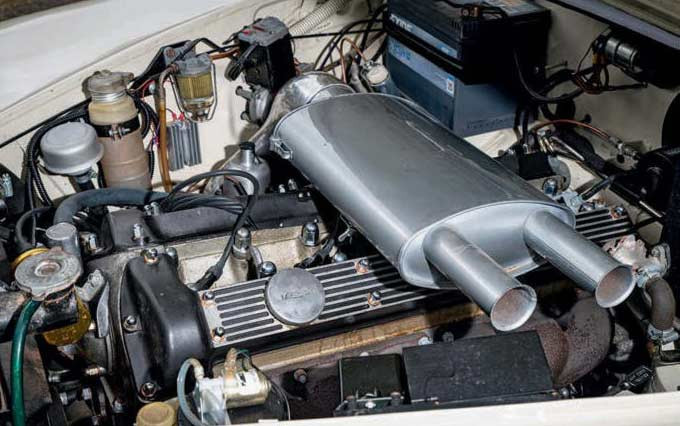
Matt was impressed with the results and fortuitously, the freeing of workshop space meant the Jaguar could be collected and work started immediately. Even better, Chris was happy that Matt could be ‘hands-on’ in the restoration process to whatever degree he desired.
Comprehensive inspection revealed a concoction of significant corrosion, water-damaged trim and seized mechanical components, leading to the recommendation that the car needed to be stripped to the last nut and bolt if a satisfactory outcome was to be achieved. Somewhat shaken, Matt acquiesced to the diagnosis and work commenced. The sentimental attachment and increasingly urgent need to return the car to the road in time for his ageing father and mother to once more ride in it overcame all of Matt’s other considerations. Work progressed quickly and soon the bare bodyshell was ready for shotblasting. This achieved, the truth was revealed… and Matt thought there must have been quite a few moths involved in the car’s storage deterioration. Undaunted, the bodywork expert at T&CC, Adrian Russell, diligently cut out all the infected areas and replaced with either repair panels or fabricated sections. In reality, the damage was far from the worst he’d previously encountered and soon the ’shell was primer-ready. It briefly crossed Matt’s mind to respray the car metallic blue in deference to his father’s original desire. In the interests of originality, however, this plan was rejected – although later in the process, a swap to red interior trim was considered a suitable homage to the initial dream.
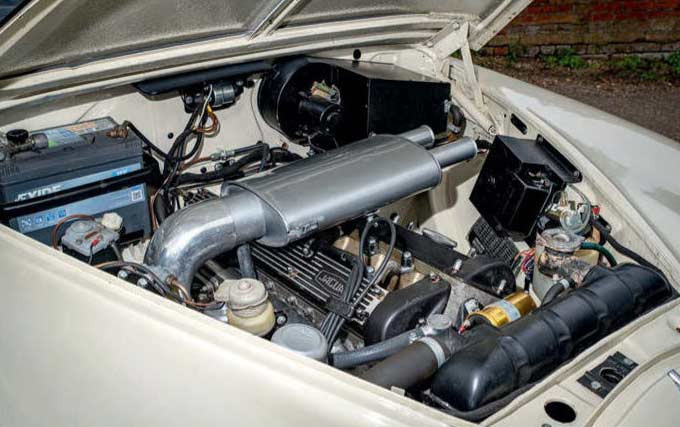
With the engine ‘on the floor’ and cylinder head, sump and crankshaft removed, Matt came to realise his career in marketing did not equip him for what was becoming a mammoth restoration task. This idea was reinforced when, whilst trying to remove the seized pistons from the bores by the well-known ‘wooden drift and sledgehammer’ method, a heart-sinking miss-hit moment resulted in irreparable damage to the original cylinder block. At that point, limitations accepted, the partially dismantled engine was dispatched to well-known specialist Ken Jenkins for his professional attentions.
Ken sourced a replacement block from his extensive used part stocks and totally rebuild the engine to as-new standards. The original cylinder head casting was retained, so still bears the number the engine left the factory with. As part of his standard procedure, Ken runs up his reconditioned engines on a test bench, and it was particularly gratifying that Matt was able to take his father along to witness this. It was an emotional moment for Ron to hear his old engine running for the first time in many years, and Ken even provided a video to record the moment for posterity.
BACK TOGETHER
Whilst the engine was away, hatching a reassembly plan was the order of the day. The required tasks were broken down into their respective skill sets, identifying which sub-projects required ‘buying in’ specific outside knowledge and experience. Headlining, interior trim and woodwork, plus rewiring demanded the utilisation of specialists and had to be achieved in the correct sequence. The running order of consecutive tasks resulted in some delays in putting the life-sized puzzle back together.
Many tasks were undertaken on site, whilst others necessitated the car being transported yet again, the interior trimmers being one instance. With all running gear dismantled, everything was blasted and painted in-house (some personally by Matt) and reassembled using new parts as required – predominantly supplied by SNG Barratt, who Matt cannot praise too highly for their efficient service, vast stock of parts and freely-supplied advice. Once the ’shell was repainted in its factory Old English White, reassembly followed apace. As much of the original car as possible was retained, supplemented by SNGB new components as well as used parts from Chris Morris, ‘The Jag Man’, who specialises in breaking lost-cause Mk2s so that others may survive. If Chris hasn’t got the part, he will help find it, such is his shared passion. All along, Matt’s two major assets of time and money were being tested, leading to balanced compromises. For example, it was far cheaper to source replacement bumpers from Chris in a reasonable condition, rather than have the originals re-chromed; and the biannual JDC spares days held at Stoneleigh’s National Agricultural Centre proved to be another happy hunting ground.
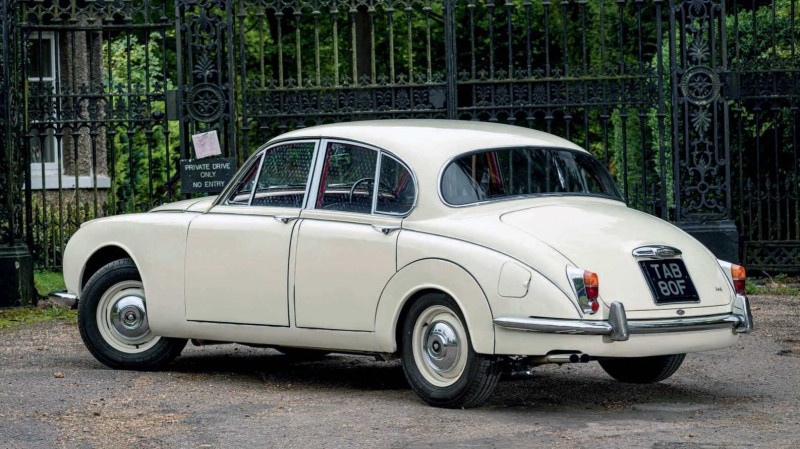
The red re-trim was entrusted to Auto Lounge Textiles in Sarratt. Against his father’s advice, Matt felt that the £1000 required to recover the seats was just a bridge too far at that point, and so the black ambla seats were retained ‘for now’. A poignant additional reason is that they still hold teeth marks along the rear of the front backrests, resulting from a strange travel habit of Matt’s elder sister (who sadly passed away when she was twenty) as a young child.
The car has been kept in as standard specification as possible, retaining original components, especially ‘touch points’ like the steering wheel, gear lever and ignition key – it matters that these were the same elements that were in Matt’s dad’s hands all those years ago. One concession, in order to alleviate the starting problems encountered late in the car’s ‘first life’, however, is electronic ignition. Following its three year restoration, the car was returned to the road in 2019, happily in time for Mum and Dad to share its maiden flight via Ludlow to view the Clent Hills. The Covid-19 pandemic and consequent lockdowns precluded further use, and both parents joined Matt’s sister during 2020. Some comfort was taken from the fact that they had enjoyed one last outing in their much-loved old Jaguar.
The car now lives in storage a 15-minute bike ride away from Matt’s home, which spoils spontaneity of use somewhat. But in the summer months, it will reside on the drive and continue to be used for family outings and local car club events.
The restoration will continue, with improvements to the woodwork and eventually those black seats. Unlike many magazine articles that end with ‘the car is now for sale’, there is no possibility of the registration document of this particular Jaguar 240 ever bearing another surname. Indeed, Matt’s two children will eventually assume the mantle of ownership, ensuring the car remains one-family-owned for decades to come.
Matt would like to thank: Town and Countryside Classics, Chris Smith: 01438 832831; www.townandcountrysideclassics.co.uk, Ken Jenkins: 01909 733209; ukjag@hotmail.com, SNG Barratt: 01746 765432; www.sngbarratt.com, ‘The Jag Man’, Chris Morris: 01525 381063; www.thejagman.co.uk


